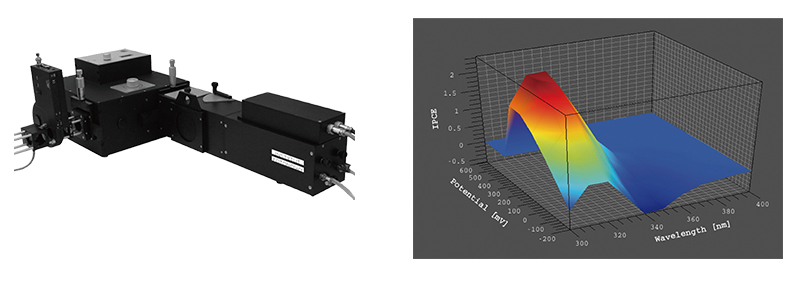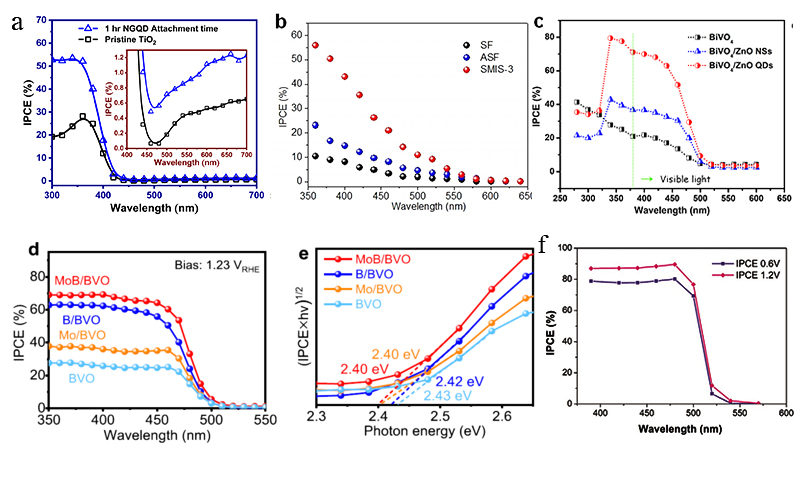The Incident Monochromatic Photon-Electron Conversion Efficiency (IPCE) is defined as the ratio of the number of electrons passing through a closed circuit to the number of incident monochromatic photons, used to evaluate the photoelectronic conversion efficiency at different wavelengths. It is one of the important indicators for assessing the photoelectrochemical performance of photoelectrodes.
Because semiconductor materials have different responses to incident light of different wavelengths, measuring the IPCE of a photoelectrode can provide a more accurate evaluation of the utilization of monochromatic photons by the photoelectrode, thereby making targeted improvements to enhance its photoelectrochemical performance[1].
The IPCE calculation formula is as follows[2]:

jph: Photocurrent density (mA·cm-2), measured by chronoamperometry (potentiostatic) method
h: Planck's constant (6.62×10-34 J·s)
c: Speed of light (3.0×108 m·s-1)
e: Charge of a single electron (1.6×10-19 C)
Pmono: Optical power density of monochromatic light (mW·cm-2)
λ: Wavelength of monochromatic light
It can be simplified as equation (2)[1]:

jp: Photocurrent density (mA·cm-2)
jd: Dark current density (mA·cm-2)
λ: Wavelength of incident monochromatic light (nm)
pin: Optical power density received by the photoelectrode (mW·cm-2)
The higher the photocurrent density of the photoelectrode, the higher the IPCE value. This can be achieved by improving the charge separation and collection efficiency of the photoelectrode material, thereby increasing the photocurrent density and enhancing the IPCE value.
The Perfectlight PL-PES Spectral Photoelectrochemical System can automatically characterize the photoelectric performance parameters of semiconductor materials in the ultraviolet, visible, and near-infrared wavelength range as a function of incident light wavelength. It can be used in conjunction with equipment such as Kelvin probes and conductivity probes, allowing control of output light wavelength, light exposure time, and synchronization with electrochemical workstations. The PL-PES Spectral Photoelectrochemical System is mainly used for photoelectric current testing under different applied voltage conditions, different light wavelengths, different light intensities, and voltage and light intensity scanning, as well as open-circuit potential testing at specific light wavelengths.

Fig.1 a) PL-PES Spectral Photoelectrochemical System; b) IPCE Curve and Photoelectric Current/Voltage Behavior Spectra

Fig. 2. a) IPCE at 0 V vs. Ag/AgCl[3]; b) IPCE at 1.2 V vs. Ag/AgCl[4]; c) IPCE[5]; d) IPCE at 1.2 VRHE; e) band gaps from photocurrent measurements[6]; f) IPCEs at 0.6 and 1.2 VRHE, respectively[7]
References
[1] Zhang Wen. Study on the Catalytic Decomposition of Water in BiVO₄-Cu₂O Tandem Photoelectrolysis Cell [D]. Xi'an: Northwest University. 2021: 9.
[2] Chen Zhebo, Deutsch Todd G., Jaramillo Thomas F.* et al., Accelerating materials development for photoelectrochemical hydrogen production: Standards for methods, definitions, and reporting protocols. Journal of Materials Research, 2010, 25, 3.
[3] Kamalesh Debnath, Tanmoy Majumder, Suvra Prakash Mondal*, Highly luminescent nitrogen doped graphene quantum dots sensitized TiO₂ nanorod arrays for enhanced photoelectrochemical performance. Journal of Electroanalytical Chemistry, 2022, 909: 116150.
[4] Zhang Hongwen, Zhang Shuncong*, Long Jinlin*, et al., The Hole-Tunneling Heterojunction of Hematite-Based Photoanodes Accelerates Photosynthetic Reaction. Angew. Chem. Int. Ed. 2021, 60:16009.
[5] Li Jinglin, Cao Haijie*, Jiao Zhengbo*, et al., The significant role of the chemically bonded interfaces in BiVO₄/ZnO heterostructures for photoelectrochemical water splitting. Applied Catalysis B: Environmental, 2021, 285: 119833.
[6] Gao Ruiting, Su Yiguo*, Wang Lei*, et al. Ultrastable and high-performance seawater-based photoelectrolysis system for solar hydrogen generation. Applied Catalysis B: Environmental, 2022, 304:120883.
[7] Wang Ying, Liu Deyu*, Kuang Yongbo*, et al., General in situ photoactivation route with IPCE over 80% toward CdS photoanodes for photoelectrochemical applications. Small, 2021, 17: 2104307.